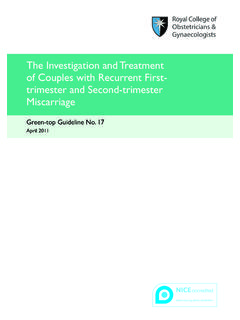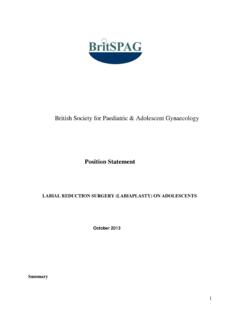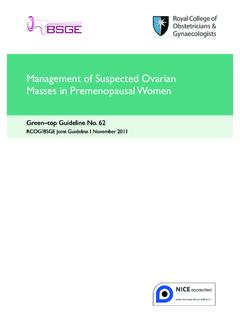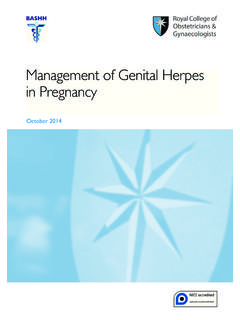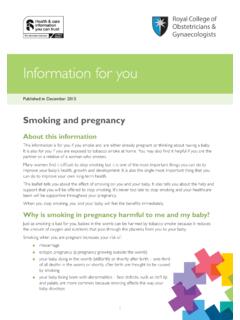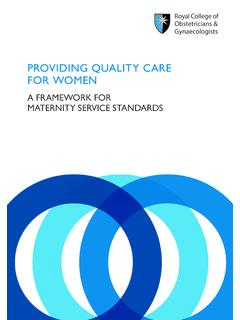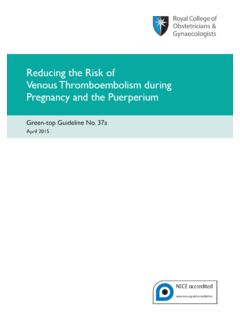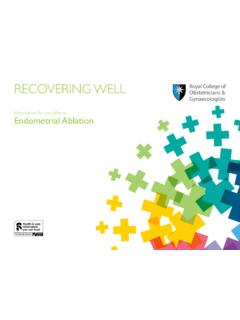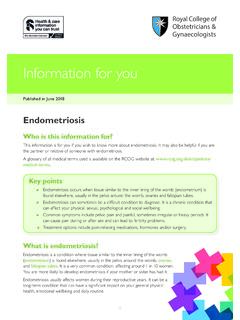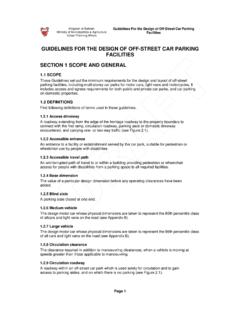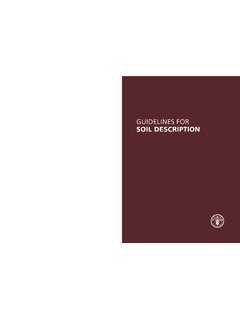Transcription of Classification of Urgency of Caesarean Section - a ...
1 Good Practice No. 11 April 2010 Good Practice No. 111 of 4 Classification OF Urgency OF Caesarean Section A CONTINUUM OF RISKP urposeA. To encourage universaluse of a nationally accepted Classification of Urgency of Caesarean Section withthe aim of: facilitating local and national data collection minimising communication difficulties relating to Urgency of delivery, between and within teams facilitating retrospective audit of To formalise the concept that Urgency of Caesarean Section represents a continuum of risk: four broad categories of risk are defined all staff should be aware that, within each category, the degree of risk in individual cases can vary a coloured spectrum is used to emphasise that continuum of risk this variance in degree of risk requires an individual, case-by-case approach in deciding the specificdecision-to-delivery interval (DDI).
2 IssuesClassificationIt is acknowledged that the traditional Classification of Caesarean Section into elective and emergency is oflimited value for data collection and audit of obstetric and anaesthetic outcomes. This is because thespectrum of Urgency that occurs in obstetrics is lost within a single emergency category. The NationalConfidential Enquiry into Patient Outcome and Death (NCEPOD) Classification , used for other surgicalprocedures, is not immediately applicable to Caesarean Section . In 2000, Lucas et a newclassification based on clinical definitions. They demonstrated that this performed better than classificationswhich relied upon visual analogue scales, assessment of maximum time to delivery, a five-point verbal ratingscale or consideration of suitable anaesthetic technique.
3 Importantly, the clinical definitions-based classifica-tion proved useful and reliable in clinical practice. The Classification has not been adopted universally, makinginter-unit comparisons of outcome difficult. In a recent paper, Kinsella and Scrutton2confirmed thatmodification of the wording of the definitions did not improve the consistency of assignment of et a three-colour code for categorising risk and suggested that this could shorten the DDIfor emergency Caesarean Sentinel Caesarean Section audit suggested that in cases such as cord prolapse, a DDI of 15 minutes , in many category-1 cases, delivery within 30 minutes was not within75 minutes does not appear to increase the risk of compromise, while delivery within 30 minutes may notalways result in a good neonatal ,6 Once a decision to deliver has been made, therefore, delivery Royal College of Obstetricians and Gynaecologists2 of 4 Good Practice No.
4 11should be carried out with an Urgency appropriate to the risk to the baby and the safety of themother. Units should strive to design guidelines that result in the shortest safely achievable DDI. Evidencesuggests that any delay is usually associated with the delay in transfer to target DDI for Caesarean Section for fetal compromise of 30 minutesis an audit tool that allowstesting of the efficiency of the whole delivery team and has become accepted practice; however: certain clinical situations will require a much quicker DDI than 30 minutes and units should work towardsimproving their efficiency undue haste to achieve a short DDI can introduce its own risk, both surgical and anaesthetic, with thepotential for maternal and neonatal communication is central to timely delivery of the fetus, while avoiding unnecessary risk to the time taken for a patient to reach the operating theatre is a critical predictor of the Communication is frequently highlighted as an area for improvement in obstetric practice.
5 All membersof the multidisciplinary team must be informed of the need (or likely need) for caesareandelivery as early as possible, as well as specific instructions on the degree of Urgency . Communication must ensure that all tasks and preparations for Caesarean Section that can be performedconcurrentlyshould be done so and that, where appropriate, roles are Communication could be more effective using a Classification that confers a more precise and individualapproach to degree of Urgency . Categorisation of risk should be reviewed by the multidisciplinary team when the mother arrives in theoperating classificationA Classification relating the degree of Urgency to the presence or absence of maternal or fetal compromise isillustrated in Figure 1. It incorporates a modified version of the Classification proposed by Lucas et scale reinforces the need to recognise that a continuum of Urgency applies to Caesarean Section ,rather than discrete categories.
6 However, it is recognised that, for audit purposes, the use of the four definedcategories remains useful. Once a category is applied to an individual Caesarean Section , all members of theteam can have a common understanding of the degree of Urgency of the procedure for that specific use of an evidence-based Classification for categorising Urgency of Caesarean Section whichacknowledges a continuum of risk has the following benefits: it uses a pre-existing Classification which is familiar to many units and has been endorsed by the RCOG,Royal College of Anaesthetists, the Obstetric Anaesthetists Association, the Centre for Maternal and ChildEnquiries and the Clinical Negligence Scheme for TrustsFigure 1. A Classification relating the degree of Urgency to the presence or absence of maternalor fetal compromiseUrgencyDefinitionCategoryImmed iate threat to life of woman or fetus1 Maternal or fetal compromiseNo immediate threat to life of woman or fetus2 Requires early delivery3No maternal or fetal compromiseAt a time to suit the woman and maternity services4 Royal College of Obstetricians and GynaecologistsGood Practice No.
7 113 of 4 it recognises and promotes fourdifferent categories of Urgency , in contrast to the traditional classificationof emergency and elective it helps to identify specificcases requiring immediate delivery (category 1) it encourages the clinical team to individualise risk within a given category by inclusion of the colourspectrum it may reduce potential maternal risks (for instance, by avoidance of general anaesthesia in the majority ofcases in categories 2 4 and in some cases of category 1) it avoids time-based definitions it can be integrated with the colour-coded systems presently used in some use of a universal Classification : would allow comparison of local and national audit of obstetric and anaesthetic practice, complicationsand outcomes may be used to inform on reasonable and achievable DDI in the future does not prevent units from using the 30-minute DDI for audit purposes, as recommended in standard 12of the joint working party report, Standards for Maternity Care,9particularly when it is considered thatuse of such is more closely reflective of local are encouraged to adopt the Lucas Classification of Urgency of Caesarean Section , which uses fourcategories of Urgency without specific time constraints.
8 The concept that there is a continuum of riskis emphasised by addition of the colour spectrum. An individualised approach to assessment of urgencyof delivery is required in all channels of communication are vital in cases requiring emergency Caesarean Section . Units shoulddefine the roles of each member of the multidisciplinary team to facilitate communication and effectivemanagement. This is particularly important in those cases defined as category 1 (requiring immediate delivery). The categorisation of risk should be reviewed by the clinical team when the mother arrivesin the operating test local channels of communication, units should consider introducing a formal drill for emergency Caesarean Section in their in-house teaching programmes. Such a drill could run from decision made for Caesarean Section to arrival and preparation in theatre.
9 Again, this is particularlyrelevant to cases defined as category 1. Royal College of Obstetricians and DN, Yentis SM, Kinsella SM, Holdcroft A, May AE, Wee M, et al. Urgency of Caesarean Section : a new Classification . J R Soc Med2000;93:346 SM, Scrutton MJL. Assessment of a modified four-category Classification of Urgency of Caesarean Section . J Obstet Gynaecol2009;29:110 O, Sayegh I, Decullier E, Dupont C, Cl ment HJ, Berland M, et al. Red, orange and green Caesarean sections: A new communicationtool for on-call obstetricians. Eur J Obstet Gynecol Reprod Biol2008;140:206 College of Obstetricians and Gynaecologists Clinical Effectiveness Support Unit. The National Sentinel Caesarean Section AuditReport. London: RCOG Press; 2001 [ ]. SL, Leveno KJ, Spong CY, Gilbert S, Hauth JC, Landon MB, et al.
10 Decision-to-incision times and maternal and infant outcomes. ObstetGynecol2006;108:6 J, Paranjothy S, James D. National cross sectional survey to determine whether the decision to delivery interval is critical inemergency Caesarean Section . BMJ2004;328:665 DJ, Wilkinson K, Beresford N. Interval between decision and delivery by Caesarean Section : are current standards achievable?Observational case series. BMJ2001;322:1330 IZ, Cooke I. Prospective 12 month study of 30 minute decision to delivery intervals for emergency Caesarean Section . BMJ2001;322:1334 College of Obstetricians and Gynaecologists, Royal College of Anaesthetists, Royal College of Midwives, Royal College of Paediatricsand Child Health. Standards for Maternity Care: Report of a Working Party.
